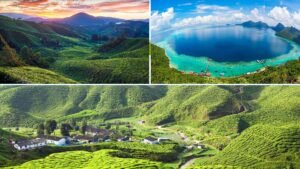Introduction
Malaysia, with its lush rainforests, pristine beaches, and vibrant marine ecosystems, stands as a beacon for eco-tourism enthusiasts. As travelers seek meaningful experiences that also contribute to environmental conservation, Malaysia emerges as a prime destination. Let’s delve into the wonders of eco-tourism in this diverse nation.
What is Eco-Tourism?
Eco-tourism goes beyond mere sightseeing; it emphasizes responsible travel that supports local communities and protects natural habitats. By choosing eco-friendly activities, travelers become stewards of the environment. Malaysia embraces this ethos, recognizing that its rich biodiversity is both a treasure and a responsibility.
Malaysia’s Natural Landscapes
Malaysia’s landscapes are a testament to its ecological wealth:
- Borneo’s Rainforests: The rainforests of Borneo—shared by Malaysia, Indonesia, and Brunei—are among the oldest and most biodiverse on Earth. Towering trees, exotic wildlife, and hidden waterfalls await those who venture into these ancient jungles. Orangutans swing through the canopy, while elusive Malayan tigers prowl the forest floor.
- Coral Reefs in the Sulu Sea: Off the coast of Sabah lies the Sulu Sea, home to vibrant coral reefs teeming with life. Divers and snorkelers encounter colorful fish, sea turtles, and delicate corals. Sipadan Island, a UNESCO-listed site, offers unparalleled underwater experiences.
- Highland Regions in Peninsular Malaysia: The Cameron Highlands and Genting Highlands provide cool escapes from the tropical heat. Here, mossy forests, tea plantations, and mist-shrouded peaks create a serene backdrop for eco-tourists. Explore hiking trails, visit organic farms, and breathe in the crisp mountain air.

Popular Eco-Tourism Destinations
Malaysia boasts several eco-tourism hotspots:
- Kinabalu Park:
- Mount Kinabalu: Rising majestically in Sabah, Mount Kinabalu is Southeast Asia’s highest peak. Trekkers ascend through diverse ecosystems, from lush lowlands to alpine meadows. The park surrounding the mountain is a UNESCO World Heritage site, harboring rare orchids, pitcher plants, and endemic bird species.
- Taman Negara:
- This ancient rainforest, spanning across Pahang, Kelantan, and Terengganu, offers immersive experiences. Canopy walks allow visitors to observe the forest from treetop heights. River trips reveal crocodiles, hornbills, and elusive tapirs. Taman Negara is a living laboratory of biodiversity.
- Sipadan Island:
- Divers flock to Sipadan for its underwater wonders. The island’s steep walls plunge into the abyss, hosting schools of barracuda, reef sharks, and sea turtles. Strict visitor limits ensure minimal impact on the delicate ecosystem. Conservation efforts focus on preserving this marine paradise.

Lesser-Known Eco-Tourism Gems
While the popular destinations shine, Malaysia hides lesser-known gems:
- Belum-Temengor Forest Reserve:
- In Perak, this pristine rainforest remains relatively untouched. Explore its tranquil lakes, spot hornbills, and listen to the haunting calls of gibbons. The Royal Belum State Park is a sanctuary for endangered species.
- Bako National Park:
- Sarawak’s Bako National Park combines coastal cliffs, mangroves, and dense forests. Proboscis monkeys, bearded pigs, and pitcher plants thrive here. Trekking trails lead to secluded beaches where the jungle meets the sea.

Conservation Efforts Linked to Eco-Tourism
Malaysia’s commitment to conservation is evident:
- Habitat Preservation: National parks and reserves safeguard critical habitats.
- Species Protection: Projects focus on saving endangered species like the Malayan tiger and the Bornean pygmy elephant.
- Community-Based Initiatives: Eco-tourism benefits local communities, encouraging their involvement in conservation.






